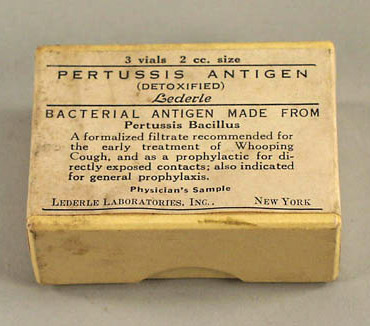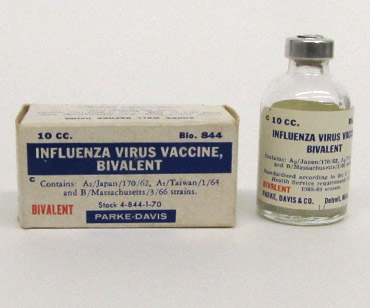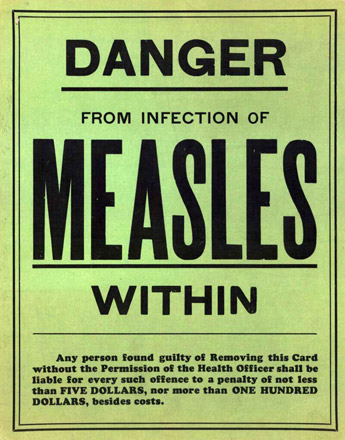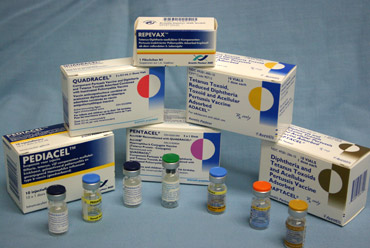Vaccines & Immunization: Epidemics, Prevention & Canadian Innovation, The Online Exhibit
-
 Smallpox warning banner, ~1920-30s
Smallpox warning banner, ~1920-30s
Image source: Museum of Health Care (unaccessioned) -
 Canada’s last smallpox case, 1962
Canada’s last smallpox case, 1962
Image source: Sanofi Pasteur Canada -
 “Smallpox is Dead!” – World Health, May 1980
“Smallpox is Dead!” – World Health, May 1980 -
 Diphtheria Antitoxin (Park, Davis & Co.),1908.
Diphtheria Antitoxin (Park, Davis & Co.),1908.
Image source: Museum of Health Care,accession #997001096 -
 Diphtheria Toxoid and Reaction Test vials,1930s.
Diphtheria Toxoid and Reaction Test vials,1930s.
Image source: Sanofi Pasteur Canada -
 Diphtheria in Toronto, 1929-1937 and theimpact of diphtheria toxoid.
Diphtheria in Toronto, 1929-1937 and theimpact of diphtheria toxoid.
Image source: Sanofi Pasteur Canad -
 Gordon Jackson in the “wooden lung,” Hospital for Sick Children, Toronto, 1937
Gordon Jackson in the “wooden lung,” Hospital for Sick Children, Toronto, 1937
Image source: Hospital Archives, The Hospital for Sick Children, Toronto (used with permission) -
 Preparing poliovirus fluids in “Medium 199,” Connaught Laboratories, 1953-54.
Preparing poliovirus fluids in “Medium 199,” Connaught Laboratories, 1953-54.
Image source Sanofi Pasteur Canada -
 Salk Inactivate Polio Vaccine (IPV), Connaught Laboratories, 1956
Salk Inactivate Polio Vaccine (IPV), Connaught Laboratories, 1956
Image source: Sanofi Pasteur Canada -
 Children at the Whooping Cough Clinic, Hospital
Children at the Whooping Cough Clinic, Hospital
for Sick Children, Toronto, 1930s.
Image source: Sanofi Pasteur Cana -
 Pertussis vaccine (standard strain), Lederle Laboratories,
Pertussis vaccine (standard strain), Lederle Laboratories,
c. 1920s.
Museum of Health Care, accession #1997.2.7 -
 Louis Pasteur (left) and Joseph Meister receiving the first Pasteur Rabies Treatment, 1885.
Louis Pasteur (left) and Joseph Meister receiving the first Pasteur Rabies Treatment, 1885.
Image source: Sanofi Pasteur Canada -
 Seasonal influenza vaccine prepared by Parke,
Seasonal influenza vaccine prepared by Parke,
Davis & Co., for the 1968-69 flu season.
Museum of Health Care, accession #000001283 -
 Measles public health placard, c. 1950s
Measles public health placard, c. 1950s
Image source: Sanofi Pasteur Canada -
 Family of combination vaccines produced by Sanofi Pasteur, c. 2006.
Family of combination vaccines produced by Sanofi Pasteur, c. 2006.
Image source: Sanofi Pasteur Canada
Vaccines and immunization are clear success stories. Yet, because vaccines are so successful at preventing disease, the public often takes them for granted. Vaccines are not perfect, but their importance becomes unmistakable when the history of infectious diseases and the development of vaccines designed to prevent them are explored together.
This online exhibit is an extension of a physical exhibit mounted at the Museum of Health Care in Kingston, which opened in November 2013. The main focus is on four key vaccines and the deadly and/or disabling diseases they prevent: smallpox, diphtheria, poliomyelitis and pertussis (aka whooping cough).
The primary goals are to look back on the unique Canadian experience with these diseases and their personal impact before the vaccines became available, focus the spotlight on the major role Canadian scientists played in their development, production and use, and underscore their public health importance in preventing, controlling or eradicating these diseases.
The online exhibit also highlights the history of several other dangerous disease threats and the vaccines designed to prevent them from a Canadian perspective: rabies, tetanus, tuberculosis, influenza, measles and Haemophilus influenza type b (Hib).
The main focus of this exhibit is historical, but with an emphasis on the ongoing importance of vaccines for children, youth and adults from a public health perspective.
This exhibit is designed to showcase the Museum of Health Care’s collection and to supplement existing information that is available from other websites about vaccines that are historical, public health or medically focused.
A key goal is to use the dramatic power of historical example and perspective about the impact of serious, debilitating and deadly diseases in Canada before and after vaccines were available to better inform those making decisions about immunization for themselves, their families, and for the wider community.


